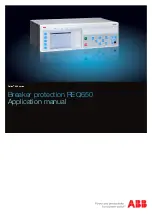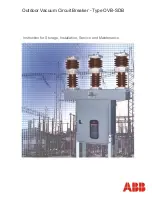
Instruction Book
Page 26
Effective: February 2007
For more information visit: www.EatonElectrical.com
I.B. 8295A61H07
SECTION 5: DESCRIPTION AND
OPERATION
Cutler-Hammer Type VCP-WR breaker elements are
vacuum type interrupting elements designed to offer
value added construction. The VCP-WR Red Line family
of circuit breaker elements is comprised of three
element types (Series 18, Series 20 and Series 29). The
nominal widths are 18 inches for Series 18, 20 inches
for Series 20 and 29 inches for Series 29 (Figures
3-1,
3-3
and
3-5
)
.
Any one of the three available elements
can be used as a retrofitting drawout breaker when
others provide and combine the appropriate cell
interface, truck, levering mechanism, secondary
connections, interlocks and other accessory items with
the VCP-WR element. VCP-WR elements can also be
used for fixed breaker applications with the customer
responsible for all required interfaces and interphase
barriers. The appropriately sized interphase barriers must
be installed to comply with individual rating electrical
clearance requirements as described in Section 6. A
movable truck and levering mechanism would not be
required for a fixed breaker application. Details
concerning mechanical and electrical interfacing needs
associated with the use of a VCP-WR breaker element
are found in Section 6 of this instruction book.
5-1 CIRCUIT BREAKER ELEMENTS
Series 18, 20 and 29 VCP-WR circuit breaker elements
are designed and tested for use and installation in
keeping with ANSI Standard C37.59. The three circuit
breaker element designs can be used for drawout or
fixed applications depending upon how others use
and/or retrofit the VCP-WR breaker elements. All safety
inter-locks required by ANSI Standards are part of the
breaker element and are integral to all three designs.
Certain required interlocks, however, are only complete
when compatible cell interlock devices are provided.
The matching cell interlocks, whether mechanical or
electrical, are the total responsibility of the customer.
Interfacing information is provided in this instruction
manual to simplify the interfacing task.
The highly reliable mechanisms for all three designs are
similar front, vertically mounted spring stored energy
types. The designs not only aid with personal safety, but
also provide for simplified inspections and servicing
accessibility (Figure
5-1
).
Circuit breaker duty vacuum interrupters are used to
close and open primary circuits. The vacuum interrupters
used have a proven record for reliability, long life and
minimal maintenance (Figures
3-2, 3-4
and
3-6
).
The standard primary insulation used on all VCP-WR
breaker elements is high strength, flame retardant glass
polyester. Cycloaliphatic epoxy primary insulation is an
available option with the Series 29 VCP-WR breaker
element. Type SIS AWG #14 wire is used on all
VCPWR control circuits.
5-2 INTERRUPTER ASSEMBLY
Vacuum interrupters are mounted vertically and
supported from the fixed stem fastened to the top or
bottom conductor, depending upon which VCP-WR
breaker series. The Series 20 VCP-WR breaker element
clamps the fixed stems to the bottom conductors (Figure
5-2
)
.
The Series 18 and 29 breaker elements clamp the
fixed stems to the top conductors (Figures
5-3
and
5-4
)
.
All configurations, however, utilize a patented V-flex
non-sliding current transfer system. The current transfer
system consists of a series of tin-plated, high-
conductivity copper leaf conductors that are swaged
onto the movable interrupter stem. This provides a multi-
point contact resulting in low electrical and thermal
resistance. Since the current transfer from the movable
stem to the circuit breaker conductor is a non-sliding
design, no maintenance is required.
5-2.1 VACUUM INTERRUPTER
Type VCP-WR breaker elements utilize vacuum
interrupters for interruption and switching functions
(Figure
5-5
).
Vacuum interruption offers the
advantages of enclosed interrupters, reduced size and
weight, short interrupting time, long life, reduced
maintenance, and environmental compatibility.
Arc interruption is simple and fast. In the closed
position, current flows through the interrupter. An arc is
drawn between the contact surfaces when the contacts
are opened. It is rapidly moved around the slotted con-
tact surfaces by a self-induced magnetic force which
prevents gross contact erosion as well as the formation
of contact surface hot spots. The arc burns in an ionized
metal vapor which continually leaves the contact area
and condenses on the surrounding metal shield. At cur-
rent zero the arc is extinguished and vapor production
ceases. Very rapid dispersion, cooling, recombination,
and deionization of the metal vapor plasma together
with fast condensation of metal vapor products cause
the vacuum to be quickly restored. Hence, the opened
contacts withstand the transient recovery voltage.
Summary of Contents for Cutler-Hammer VCP-WR Series
Page 2: ......
















































